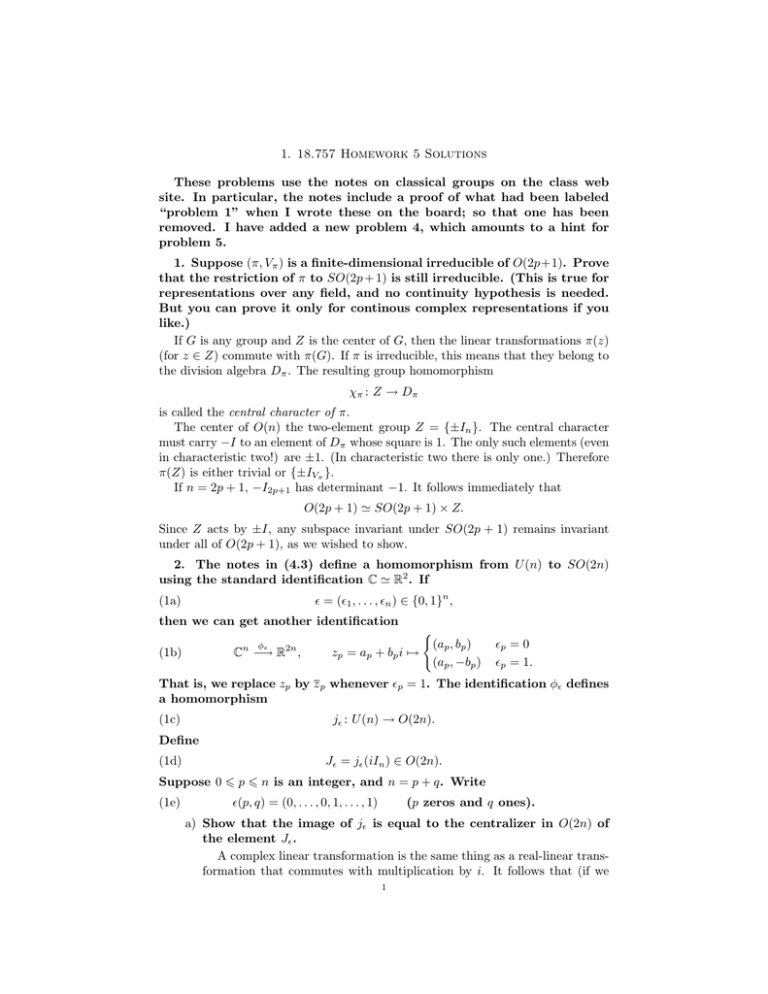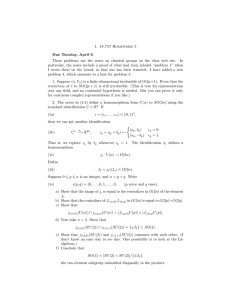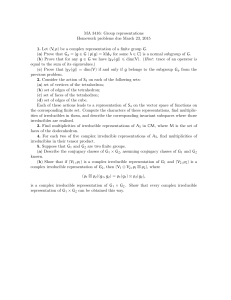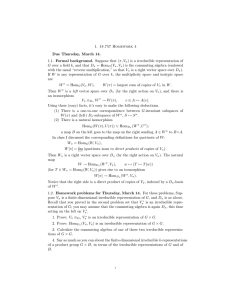1. 18.757 Homework 5 Solutions
advertisement

1. 18.757 Homework 5 Solutions
These problems use the notes on classical groups on the class web
site. In particular, the notes include a proof of what had been labeled
“problem 1” when I wrote these on the board; so that one has been
removed. I have added a new problem 4, which amounts to a hint for
problem 5.
1. Suppose (π, Vπ ) is a finite-dimensional irreducible of O(2p+1). Prove
that the restriction of π to SO(2p + 1) is still irreducible. (This is true for
representations over any field, and no continuity hypothesis is needed.
But you can prove it only for continous complex representations if you
like.)
If G is any group and Z is the center of G, then the linear transformations π(z)
(for z ∈ Z) commute with π(G). If π is irreducible, this means that they belong to
the division algebra Dπ . The resulting group homomorphism
χπ : Z → Dπ
is called the central character of π.
The center of O(n) the two-element group Z = {±In }. The central character
must carry −I to an element of Dπ whose square is 1. The only such elements (even
in characteristic two!) are ±1. (In characteristic two there is only one.) Therefore
π(Z) is either trivial or {±IVπ }.
If n = 2p + 1, −I2p+1 has determinant −1. It follows immediately that
O(2p + 1) ' SO(2p + 1) × Z.
Since Z acts by ±I, any subspace invariant under SO(2p + 1) remains invariant
under all of O(2p + 1), as we wished to show.
2. The notes in (4.3) define a homomorphism from U (n) to SO(2n)
using the standard identification C ' R2 . If
= (1 , . . . , n ) ∈ {0, 1}n ,
(1a)
then we can get another identification
(
n
φ
2n
C −→ R ,
(1b)
zp = ap + bp i 7→
(ap , bp )
(ap , −bp )
p = 0
p = 1.
That is, we replace zp by z p whenever p = 1. The identification φ defines
a homomorphism
j : U (n) → O(2n).
(1c)
Define
(1d)
J = j (iIn ) ∈ O(2n).
Suppose 0 6 p 6 n is an integer, and n = p + q. Write
(1e)
(p, q) = (0, . . . , 0, 1, . . . , 1)
(p zeros and q ones).
a) Show that the image of j is equal to the centralizer in O(2n) of
the element J .
A complex linear transformation is the same thing as a real-linear transformation that commutes with multiplication by i. It follows that (if we
1
2
extend the definitions appropriately) the image j (GL(n, C)) is equal to the
centralizer in GL(2n, R) of J .
An element of U (n) is an element of GL(n, C) that preserves length
of vectors in Cn . An element of O(2n) is an element of GL(2n, R) that
preserves length of vectors in R2n . The identification φ of Cn with R2n
preserves length of vectors.
The claim follows from these two paragraphs.
b) Show that the centralizer of J(n,0) J(p,q) in O(2n) is equal to O(2p)×
O(2q).
The matrix of J consists of 2 × 2 blocks on the diagonal
0 −1
0 1
(p = 0),
(p = 1).
1 0
−1 0
It follows that J(n,0) J(p,q) consists of p 2 × 2 diagonal blocks −I2 , and q
2 × 2 diagonal blocks I2 ; that is
−I2p 0
J(n,0) J(p,q) =
.
0
I2q
The centralizer of this matrix consists of all matrices of the form
A 0
,
0 B
with A and B square of sizes 2p and 2q respectively. The claim follows.
c) Show that
j(n,0) (U (n)) ∩ j(p,q) (U (n)) = [j(p,0) U (p)] × [j(0,q) U (p)].
(The original problem mistakenly wrote J in the last formula.) We need
to compute the common centralizer of the two matrices J(n,0) and J(p,q) .
This centralizer is contained in the centralizer of the product matrix, which
was computed in (b) to be O(2p) × O(2q). Since the matrices J respect
this product decomposition, it follows that the intersection is
cent in O(2p) of J(p,0) and J(p,0) × cent in O(2q) of J(q,0) and J(0,q) .
This is
cent in O(2p) of J(p,0) × cent in O(2q) of ±J(q,0) ,
which is what we want by (a).
d) Now take n = 2. Show that
j(2,0) (SU (2)) ∩ j(1,1) (SU (2)) = {±I4 } ⊂ SO(4).
According to (c),
j(2,0) (U (2)) ∩ j(1,1) (U (2)) = [j(1,0) U (1)] × [j(0,1) U (1)]
r(φ1 )
0
=
.
0
r(−φ2 )
3
Here r(φ) is the 2 × 2 orthogonal matrix of the rotation through an angle
φ. The indicated matrix in SO(4) is equal to
iφ
iφ
e 1
0
e 1
0
j(2,0)
= j(1,1)
.
0
eiφ2
0
e−iφ2
The change in the sign (complex conjugation) on the φ2 term arises because
in the first case we are using the isomorphism j0 : U (1) → SO(2) and in
the second case j1 . The problem asks us to restrict to complex matrices of
determinant 1; that is, to φ1 + φ2 ∈ 2πZ in the first case, and to φ1 − φ2 ∈
2πZ in second. The simultaneous solutions of these two requirements are
φj ∈ πZ,
φ1 + φ2 ∈ 2πZ.
Equivalently,
eiφ1 eiφ2 = 1.
eiφj = ±1,
Because rotation by π is −I2 , the matrices in SO(4) are
±I2
0
,
0
±I2
and the two signs must be the same. This is what we wished to show.
e) Show that j(2,0) (SU (2)) and j(1,1) (SU (2)) commute with each other.
(I don’t know an easy way to see this. One possibility is to look
at the Lie algebras.)
(Proof to be added later.)
f) Conclude that
SO(4) ' [SU (2) × SU (2)]/{±I2 },
the two-element subgroup embedded diagonally in the product.
Because of (e), the maps in (d) define an injective Lie group homomomorphism from the right side to the left. We know (for example from the
classical groups notes)that SU (2) has real dimension 22 −1 = 3, and SO(4)
has real dimension 42 = 6. Therefore the image of the right side has the
same dimension as the left side. By Lie theory, the image is open. Since
SO(4) is connected, any open subgroup is equal to SO(4); so the map is
bijective. Since SU (2) is compact, it follows that the map is a homeomorphism.
3. Write Hm (n) for the complex representation of O(n) on complexvalued harmonic polynomials of degree
m. Recall
that Hm (n) is irre
m+n−3
ducible or zero, of dimension m+n−1
−
,
and
that
n−1
n−1
Hm (n)|O(n−1) =
m
X
Hp (n − 1)
p=0
for n > 2. In particular,
dim Hm (O(4)) = (m + 1)2 ,
Hm (4)|O(3) = Hm (3) ⊕ Hm−1 (3) ⊕ · · · ⊕ H0 (3).
The formula for dimensions corresponding to the last statement is
(m + 1)2 = (2m + 1) + (2m − 1) + · · · + 1.
4
Show that Hm (4) remains irreducible on restriction to SO(4).
The subgroup SO(4) has index two in O(4) By Clifford theory discussed in class,
the only alternative to irreducibility is that the restriction to SO(4) is a direct sum
of two irreducible representations interchanged by the action of O(4)/SO(4) on
irreducibles of SO(4). Because the component group is generated by the matrix
I3 0
0 −1
which centralizes SO(3), it collows that in this case the two irreducibles of SO(4)
would have to have isomorphic restrictions to SO(3).
On the other hand, problem 1 says that the restriction of Hm (4) to SO(3) is
the sum of irreducible representations of dimensions 1, 3,. . . , 2m + 1. Since the
dimensions are distinct, these representations are all inequivalent; so they cannot
be partitioned into two isomorphic sets. Therefore the reducible restriction case is
impossible.
4. The inclusion j(2,0) of SU (2) in SO(4), and equations (4.4) in the
notes, define an action of the unit quaternions on the sphere in R4 ; that
is, on the unit quaternions. Show that this action is left multiplication.
Show that the corresponding action defined using j(1,1) is right multiplication by the inverse. (Recall that the inverse of a unit quaternion is
equal to its conjugate.)
According to the notes, the unit quaternion z + wj acts on C2 (through the
isomorphism with SU (2)) by the matrix
z −w
.
w
z
The isomorphism of C2 with H is
a
7→ a + jb.
b
(The reason the b appears on the left is that we regard H as a right vector space
over H, and therefore by restriction as a right vector space over C. The action of
SU (2) sends the basis vector 1 0 to z w ; that is, it sends the quaternion 1
to z + jw = z + wj, which is left multiplication by z + wj. Similarly, it sends j to
−w + jz = −w + zj = (z + wj)j.
This proves that the first Sp(1) ' SU (2) is indeed acting by left multiplication on
H. The calculation for the second SU (2) is similar.
5. Show that SU (2) has exactly one irreducible continuous complex
representation Vm of dimension m for every integer m > 1.
According to the Peter-Weyl theorem,
L2 (SU (2)) = ⊕πirreducible Vπ ⊗ Vπ∗ ;
this is the decomposition into irreducible representations of SU (2) × SU (2). According to problems 3 and 4,
L2 (SU (2) = ⊕m>1 Hm−1 (4),
with Hm−1 (4) an irreducible representation of SU (2) × SU (2) of dimension m2 .
The claim follows by comparing these two formulas.








